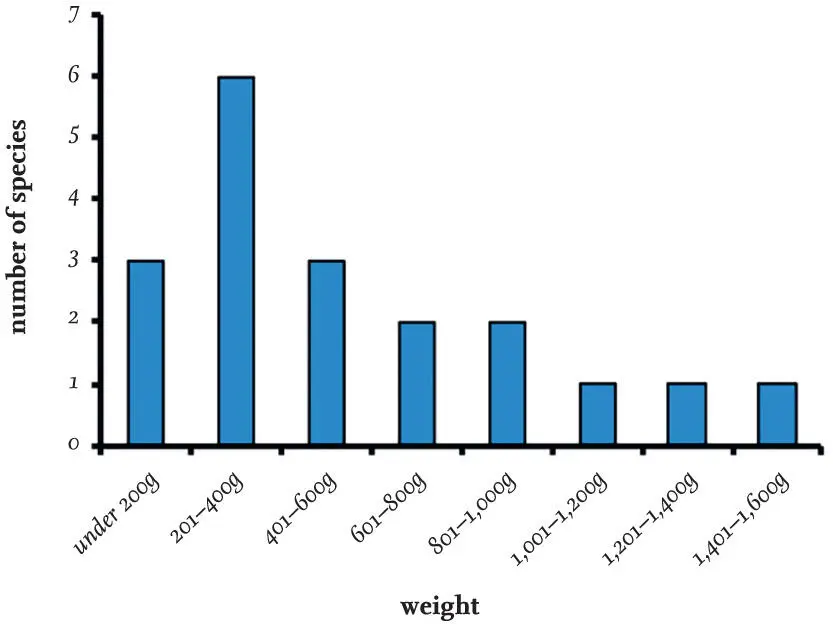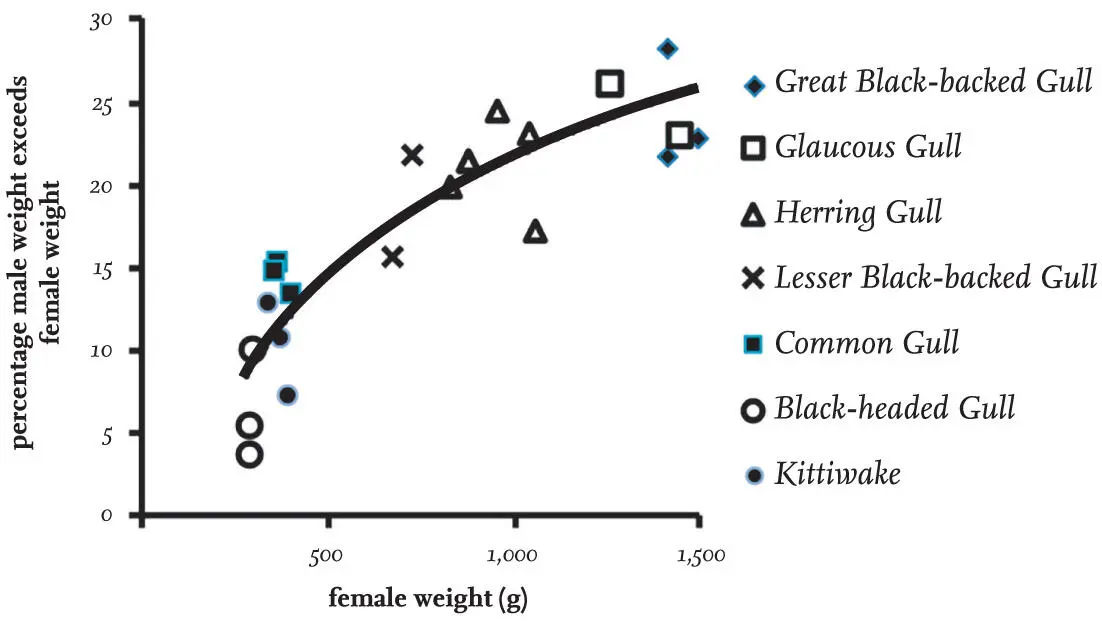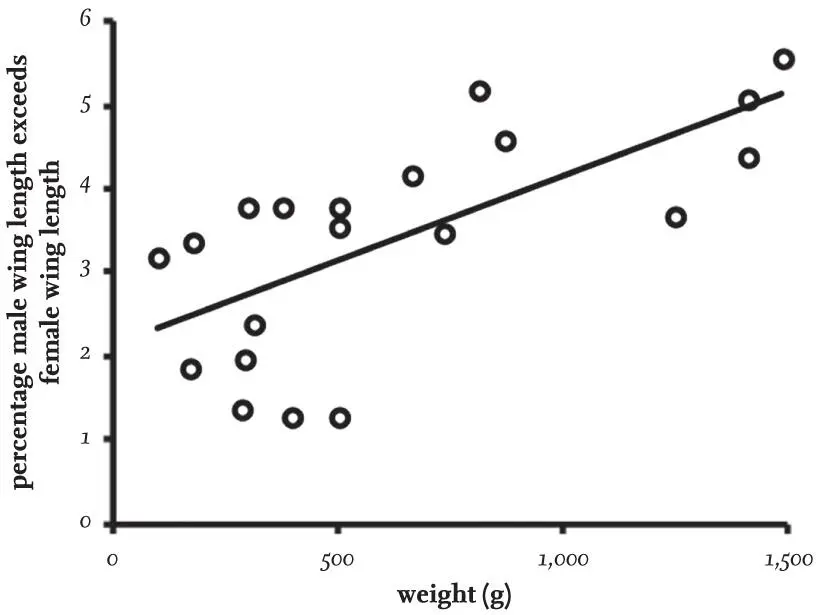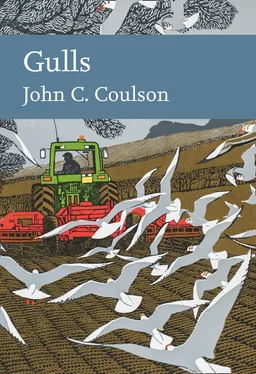1 ...6 7 8 10 11 12 ...29 SIZE DIFFERENCES BETWEEN SPECIES
Gull species vary considerably in size. The Little Gull is the smallest and weighs about 100 g (the weight of an Arctic Tern, Sterna paradisaea), while the largest is the Great Black-backed Gull, with males averaging 1,800 g and some individuals exceeding 2,000 g. Fig. 4
shows the average weights of adult females of 19 gull species on the British list. The weights of females of nine of these species are less than 400 g on average and overlap with terns, of which the adult females of all except one species on the British breeding list weigh under 400 g. The distribution chart for male weights is similar, but is shifted to the right because of their slightly greater size.

FIG 4. The average weight of the females of 19 gull species on the British list.
INDIVIDUAL VARIATION
Like all animals, individuals of each gull species show variation in many characters, including size, colour and age at first breeding. Males are larger than females and tend to have a more substantial bill, and size within a species can also vary geographically.
Variation in the immature plumage is widespread in gulls of the same age and this is frequently overlooked in the field identification of species, particularly within the genus Larus. The occurrence of hybrid individuals further adds to plumage variation and typical examples of hybrids can often be identified in the field by experienced observers; the characteristics used often overlap with those of other species. Consequently a proportion of immature and even adult birds that are infrequently recorded in Britain and Ireland may fail to be identified because of potential confusion with other species.
Immature plumages
The plumage, leg and bill colours of recently fledged chicks are very different from those of their parents, to such an extent that, many years ago, a first-year Kittiwake was claimed as a species new to science, despite the adult having already been described and named some years earlier. The first plumage of the young of most gull species is made up of feathers of varying shades of brown and grey, producing a cryptic pattern that helps to conceal them in vegetation in a colony and also appears to reduce aggression from adults. In the smaller gull species, the plumage is replaced by one that resembles the adult at the first annual moult; that is, when the bird is 13 months or so old. In the larger species, all feathers are replaced each year, but only some of the new ones resemble those of the adults and the full adult plumage pattern is not achieved until four years after hatching. These progressive changes in plumage at successive annual moults can vary between individuals and produce a series of different plumage patterns that make it a challenge to identify both the species and the age of immature individuals.
The slow and progressive acquisition of the adult plumage through successive moults contrasts with the rapid growth of bones and wing feathers, which reach full size within a few weeks after hatching because they are necessary before flight can be achieved. Why the acquisition of the adult plumage takes longer in the larger species of gull than in the smaller ones is not clear. The mechanism determining plumage patterns is obviously controlled by hormones and is linked with the greater length of immaturity in the larger gull species, but it is not evident why the large species delay reaching maturity for so long.
Differences between the sexes
The sexes of gulls have identical plumage and differ only in that females are usually smaller and tend to have slightly less substantial bills. Fig. 5
shows the relationship between the differences in weight of male and female gulls of seven species, using data from different parts of their geographical ranges where available. The extent of the difference between sexes is not constant from species to species, but increases with the weight of the species, ranging from a 5 per cent increase in the Black-headed Gull to more than 20–25 per cent in large species.
Standard measurements of wing length also tend to be longer in males than in females, but the magnitude of the difference is much smaller, ranging from 1 per cent in some small species to 6 per cent in the largest species ( Fig. 6
). Even when this difference is converted to wing area, it still results in the wing loading being higher in the large gulls, which explains why these species typically have a more laboured flight, with a slower, more powerful wing-beat. The small gull species, which are of similar weight to many tern species, have a characteristic buoyant flight similar to that of terns.

FIG 5. The percentage by which male gulls of several species are heavier than females, based on data for seven well-studied species. It is evident that there is a much greater difference between the size of males and females in the larger species of gulls.

FIG 6. The relationship between adult weight and the extent to which the male has a longer wing than females. The percentage difference in wing length between the sexes increases in heavier species, but is much less than the difference of body weight shown in Fig. 5
.
The reason why there is a greater size difference between the sexes in large gull species is not known, and currently it is possible only to speculate. Perhaps there is a greater need in the large species to reduce competition for food between the sexes, or perhaps the dimorphism is related to the greater need for males of large species to defend nesting territories. The reader might speculate further, bearing in mind that in the skuas, females are invariably larger than males, while male terns are only 1–3 per cent heavier than females.
Despite the average size differences, there is an overlap in the range of sizes of male and female gulls. Niko Tinbergen claimed that, despite the overlap in size between the sexes of Herring Gulls, invariably the male is larger in every pair. Because of the average difference in size between the sexes, by chance the male will be larger than the female in many pairs, and more so in the larger gull species, but I have not found evidence that the male is invariably larger than the female. Size, and particularly the size of the bill, may play a part in individual birds recognising the sex of other gulls, but it is more likely that behaviour – particularly during courtship – plays the major role in sex recognition in gulls, especially in smaller species.
Sexing gulls
As male and female gulls have identical plumage features, distinguishing them in the field can be very difficult. The most reliable way to determine the sex of an individual bird – without killing it and then dissecting it to examine the gonads – is by carrying out a DNA analysis on samples obtained from feathers or blood. While this method is highly efficient, it is time consuming and it is expensive when large numbers of birds are being studied. In the field, biometric measurements taken while a bird is temporarily captured for ringing can also be used for sexing the individual. I found that the best measure was the head and bill length (from the back of the head to the bill tip), which also had the advantage of showing the highest degree of consistency when measured by different people. Further, the proportionate difference in head and bill length between the sexes is almost twice that for wing length (for example, 9.6 per cent compared to 5 per cent in the Great Black-backed Gull). The only disadvantage of this measure is that in some museum specimens part of the back of the skull was removed during preparation, which prevents it being used in these cases. As shown in Table 2, the head and bill measurement is satisfactory in sexing 92–98 per cent of individuals of several gull species. Including two other body measurements (wing length and bill depth) in a discriminant analysis increased the accuracy of sexing only by less than 2 per cent points.
Читать дальше















